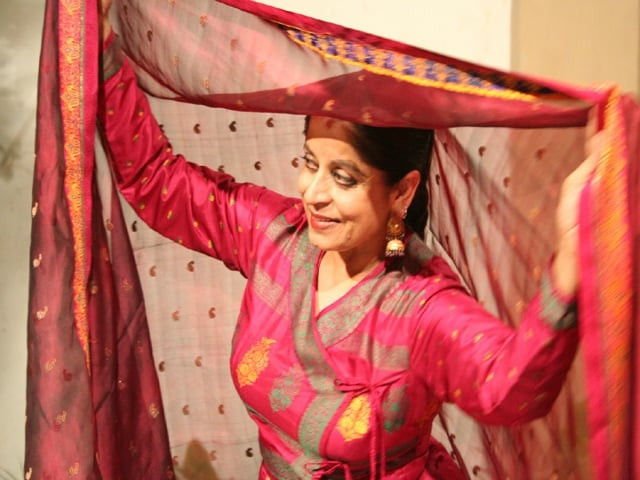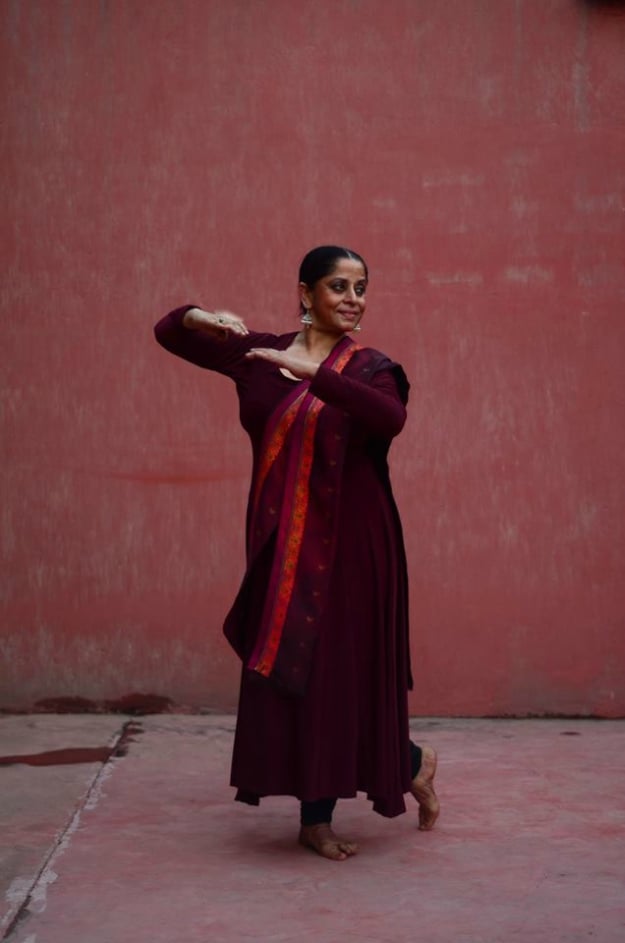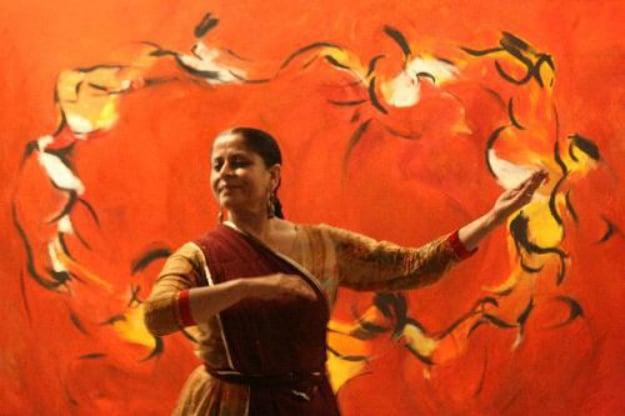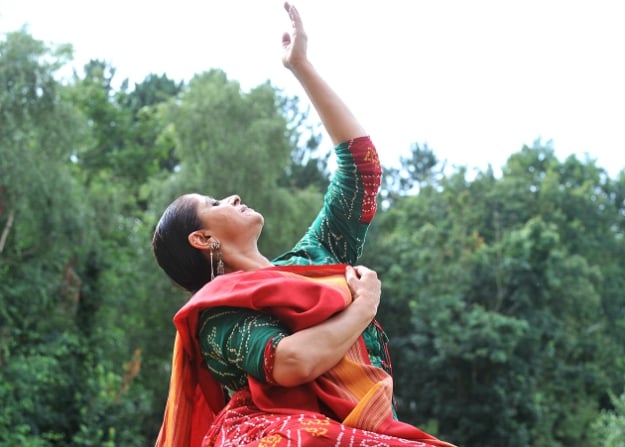Nahid Siddiqui: A ‘katha’ of this life
Iconic kathak dancer shares her passion for ancient dance form and how it has been lost in the “ugliness” of...

PHOTO: FILE
As the eldest daughter of renowned yesteryears actor Talat Siddiqui, Nahid has been performing for decades now and been a disciple of two great teachers: Baba Maharaj (also known as Mahajar Ghulam Hussain Kathak) and Birju Maharaj. Of course, as someone with very little knowledge of ancient dance forms, I only found this out upon meeting her. I went into the interview with a layman’s curiosity and she entered the lounge with a double-handed grip on her mug of tea and a big smile on her face.
 PHOTO: FILE
PHOTO: FILEInstantly, you can notice the poise of a performer in Nahid’s stance. She shares her exposure to kathak was through her mother who took her to variety shows in Karachi. “I got the opportunity to go to these shows which she’d often host. And the image that lingered long after was not of acting or singing, but of the visual beauty of a dance performance,” the cultural icon tells The Express Tribune.
Nahid takes something like a verse from Bulleh Shah or Ami Khusrow, visualise it through body movements on stage, and somehow, the entire experience becomes one of transcendence. “I once did a piece on the four elements of life – fire, air, water and earth. And I had to figure out how to be air, and it was extremely difficult. How to be water? How to capture that essence?” Nahid reminisces. “I figured that I had to be so light, and I had to make sure the movement wasn’t jarring at all.”
She hereby quotes a verse by the legendary Faiz Ahmed Faiz. “Sham ke paich o kham sitaaron se, zeena utar rahi hai raat (From the entangled stars of the evening, the night is falling). Faiz gave this visual to me, but it’s so difficult yet beautiful to translate it in a dance performance,” Nahid shares. She makes sure I understand that the process of finding meaning in words and music and projecting it through the vessel of her body is what she lives for. She’s an artist at work; a madman who sees the cosmos in colourful, miniature glass globes.
 PHOTO: FILE
PHOTO: FILE“When I dance, I forget the material world. And you can only perform well if you don’t have anything to hide. Only a free soul can dance,” says the dancer. I realise that this is her secret: Nahid is a swimmer who dives into deep waters and forgets about the land or a worshipper who loses herself in sacred chants. She pointed to her body and says, “This is the canvas that I take everywhere with me. And I paint.”
Her analogy does in fact offer a clearer picture. Kathak, as a dance form, has evolved over thousands of years of history. The word itself comes from ‘katha,’ meaning story with ‘kathak’ being the storyteller. The art form, which started off in Hindu traditions, was a vessel for Hindu religious stories and could often be seen at temples. Nahid explains how it is different from other forms of classical dance saying, “It’s like different dialects of a language. They differ in nuances and each has focus on a different element.”
The Mughal era was when kathak’s boundaries were expanded to Muslim and Sufi sensibilities as well. “Poetry, geometry and mathematics, all of which flourished under the Mughal rule, are great aspects of kathak,” says Nahid. “The Mughals chose this art form because, as compared to others, it was expandable and could be moulded. It’s comparatively the most natural dance form.”
 PHOTO: FILE
PHOTO: FILEAccording to Nahid, kathak is – in its essence - similar to the Chinese martial arts form Tai Chi, with its slow movement which emphasises body and arm control. “Footwork is very important in Kathak as well.”
She goes one to draw a comparison with the Spanish Flamenco dance form as well. “Gypsies traveled from Rajasthan and took the influence of raw Kathak at the time. The base of Spain’s Flamenco dance is actually Kathak but the only differences are the use of castanets and that Flamenco dancers wear shoes. But the base is the same.”
Nahid says the widespread influence of kathak and its fluidity and “naturalness” are some of the reasons why it’s used in films so often. “Kathak is not stylised. That’s why films also take the costumes of Kathak,” she comments. “But it doesn’t leave a lasting impression. The portrayal then comes under entertainment, not art.”
 PHOTO: FILE
PHOTO: FILEImagine going to an art gallery and asking the painter about a particular piece that catches your attention. More often than not, he or she will turn around and ask you what you make of the image. Nahid demands the same respect for her art.
“I’m the one who refused to dance in front of dinner tables; that setup put me off,” she reveals. “People assured me nobody would move and that there had to be dinner after the performance but I refused. That is no respect for the artist. I am not a cabaret dancer!”
Nahid goes on to narrate an incident from many years ago. “Bollywood actress Hema Malini and I were performing in two separate halves of a show in Dubai once. I was quite young and doing the first half. The setting was the same: dinner tables,” she recalled. “Coming from Pakistan, I was more familiar with it, and also wasn’t in a position to dictate what I wanted. But Hema Malini came and grimaced upon seeing the setup and walked out. Everyone went to convince her and she argued that it was no respect to the art form or the artist. Eventually, she was convinced to perform but she wasn’t happy about it.”
 PHOTO: FILE
PHOTO: FILEThe Pakistan Pride of Performance winner sighs in joy upon remembering the moment. She appreciates the value of rituals and the respect for art people have in India but gently balances the pride in her work with humility. “Kathak has the great ability to transform and bring out the soul,” she says. “It needs a certain passion and madness to do something for an entire lifetime. I’ve done a lot of research on and performed Kathak for so long but it’s never enough. You always find something new.”
“People stop after a certain time and feel glad after achieving just a little. They become content. When you become content with what you have done, it results in mediocrity. It’s always in the hands of a practitioner how far he takes something,” adds Nahid.
Nahid has been carrying the torch of kathak in Pakistan for decades. In the late 1970s, during the Ziaul Haq regime, dancing was banned. In spite of that, Nahid continues. “How can you ban beauty? It just helped me work that much harder. A lot more people supported me because I continued performing. See, you can’t cage a society. That’s why there’s a certain mental dwarfness that’s prevalent today.”
 PHOTO: FILE
PHOTO: FILESince the ‘Islamist’ regime and the extreme changes Pakistani society has undergone in its wake, dancing is still somewhat frowned upon and considered ‘un-Islamic’ even though it’s heavily imbued in our celebrations. Nahid has an answer for that. “It’s important to educate people. Ugly entertainment has been widely propagated. People aren’t introduced to art. They say dance is not part of our religion but it has nothing to do with religion.”
She continues, “People confuse religion and spirituality. No one stopped Bulleh Shah when he said ‘Main nach ke yaar manawaan.’ They don’t have thinking minds. Abida Parveen sings, ‘Kaaba taa de, mandir ta’ de, dil na kisi da taa (Destroy the Kaaba and the temples, but don’t break someone’s heart). No one bans them. But when it comes to a woman performing, they call it body display. It’s a completely wrong mindset, that’s all.”
As she continues in her pursuit of introducing kathak to the younger generations, Nahid most recently performed and held a workshop at National Academy of Performing Arts (Napa). Her eyes glow when she mentions the standing ovation she got from the crowd, most of which comprised of youngsters. “I feel Karachi can have a lot more students and I can help generate a lot more interest in kathak here,” she says, wistfully. “But there are still no systems of teaching sangeet. I have my own notation system which breaks down the process of learning. In the earlier days, they only used to impart knowledge within the family. Now the world has changed.”
By now, Nahid’s ride has arrived and she begins to say farewell. “Kathak is the katha (story) of life. Beauty, happiness, sadness, everything is a part of it,” she adds as a parting note. “People should open up to beauty more. In a world where we’re more inclined towards ugliness, our children have to channelise their energies somewhere. Give them instruments to play with and feet to tap, and they will definitely go for that instead of other options.”
Have something to add to the story? Share in the comments below.


















COMMENTS
Comments are moderated and generally will be posted if they are on-topic and not abusive.
For more information, please see our Comments FAQ